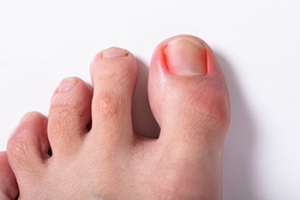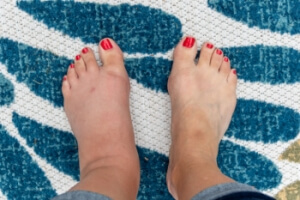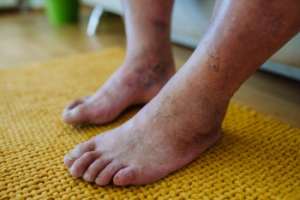
Risk Factors for Ingrown Toenails
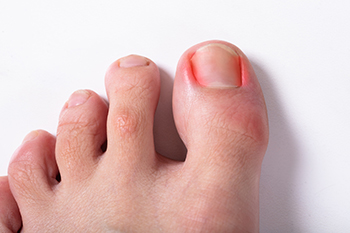 Ingrown toenails, a common condition where the nail grows into the skin surrounding the toe, have a variety of risk factors. Trimming the toenails too short or rounding the edges of the nail can encourage the nail to grow into the skin rather than over it, so proper nail trimming is important. Wearing tight footwear and socks that squeeze the toes can also contribute to the problem by pushing the nail into the toe skin. Athletes and individuals who engage in activities that put repeated pressure on the toes are at an increased risk, as this pressure can cause the nail to grow incorrectly. While genetics do not usually play a major role in causing ingrown toenails, some people are predisposed to developing them because they are born with naturally curved or thick toenails. Also, poor foot hygiene and injury to the toenail area can increase the likelihood of developing an ingrown toenail. If you are suffering from an ingrown toenail, or wish to know how to prevent ingrown toenails from occurring in the future, it is suggested that you consult a podiatrist.
Ingrown toenails, a common condition where the nail grows into the skin surrounding the toe, have a variety of risk factors. Trimming the toenails too short or rounding the edges of the nail can encourage the nail to grow into the skin rather than over it, so proper nail trimming is important. Wearing tight footwear and socks that squeeze the toes can also contribute to the problem by pushing the nail into the toe skin. Athletes and individuals who engage in activities that put repeated pressure on the toes are at an increased risk, as this pressure can cause the nail to grow incorrectly. While genetics do not usually play a major role in causing ingrown toenails, some people are predisposed to developing them because they are born with naturally curved or thick toenails. Also, poor foot hygiene and injury to the toenail area can increase the likelihood of developing an ingrown toenail. If you are suffering from an ingrown toenail, or wish to know how to prevent ingrown toenails from occurring in the future, it is suggested that you consult a podiatrist.
Ingrown toenails can become painful if they are not treated properly. For more information about ingrown toenails, contact Monique Mitchell, DPM of Family Foot Centre. Our doctor can provide the care you need to keep you pain-free and on your feet.
Ingrown Toenails
Ingrown toenails occur when a toenail grows sideways into the bed of the nail, causing pain, swelling, and possibly infection.
Causes
- Bacterial infections
- Improper nail cutting such as cutting it too short or not straight across
- Trauma to the toe, such as stubbing, which causes the nail to grow back irregularly
- Ill-fitting shoes that bunch the toes too close together
- Genetic predisposition
Prevention
Because ingrown toenails are not something found outside of shoe-wearing cultures, going barefoot as often as possible will decrease the likeliness of developing ingrown toenails. Wearing proper fitting shoes and using proper cutting techniques will also help decrease your risk of developing ingrown toenails.
Treatment
Ingrown toenails are a very treatable foot condition. In minor cases, soaking the affected area in salt or antibacterial soaps will not only help with the ingrown nail itself, but also help prevent any infections from occurring. In more severe cases, surgery is an option. In either case, speaking to your podiatrist about this condition will help you get a better understanding of specific treatment options that are right for you.
If you have any questions please feel free to contact our office located in Garden Hills, Nassau, Bahamas . We offer the newest diagnostic and treatment technologies for all your foot and ankle needs.
Ingrown Toenails
An ingrown toenail is a nail that has curved downward and grown into the skin. This typically occurs at either the nail borders or the sides of the nail. As a result, pain, redness, swelling, and warmth may occur in the toe. If a break in the skin forms due to the ingrown nail, bacteria may enter and cause an infection in the area; this is typically characterized by a foul odor and drainage.
Ingrown toenails have multiple reasons for developing. In many instances, the condition is a result of genetics and is inherited. The most common cause, however, is improper trimming; cutting the toenails too short forces the skin beside the nail to fold over. An ingrown toenail can also develop due to trauma, such as stubbing the toe, having an object fall on the toe, or participating in activities that involve repeated kicking or running. Wearing shoes that are too tight or too short can also cause ingrown toenails.
Treatment for an ingrown toenail varies between patients and the severity of the condition. In most cases, it is best to see your podiatrist for thorough and proper treatment. After examining your toe, your podiatrist may prescribe oral antibiotics to clear the infection if one is present. Surgical removal of either a portion of the nail or the entire nail may also be considered. In some cases, complete removal or destruction of the nail root may be required. Most patients who undergo nail surgery experience minimal pain afterward and can return to normal activity the following day.
Ingrown toenails can be prevented with proper nail trimming and by avoiding improper-fitting shoes. When cutting the toenails, be sure that you are cutting in a straight line and avoid cutting them too short. Shoes should not be too short or tight in the toe box.
When to See a Doctor for Swollen Feet
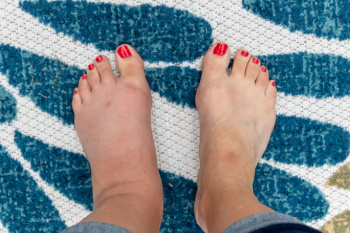 Swollen feet can be caused by various things, ranging from simple overuse to more complex health issues. While occasional swelling might not be a cause for immediate concern, especially if swelling goes down with rest and elevation, there are other times when it is important to make an appointment with a foot doctor. If the swelling is persistent, has associated pain, or only affects one foot, it may show underlying problems such as infections, injuries, or vascular disorders that require professional evaluation and treatment. Additionally, if you have pre-existing health conditions like diabetes, heart disease, or kidney problems, swollen feet could indicate complications related to these conditions. Experiencing additional symptoms such as redness, warmth, or changes in skin color around the swollen area also warrants a visit to a foot doctor. Foot doctors, also known as podiatrists, can diagnose the root cause of swollen feet and offer targeted treatment to alleviate the discomfort and any potential health risks. It is suggested that you make an appointment with a podiatrist promptly if you are experiencing persistent swollen feet.
Swollen feet can be caused by various things, ranging from simple overuse to more complex health issues. While occasional swelling might not be a cause for immediate concern, especially if swelling goes down with rest and elevation, there are other times when it is important to make an appointment with a foot doctor. If the swelling is persistent, has associated pain, or only affects one foot, it may show underlying problems such as infections, injuries, or vascular disorders that require professional evaluation and treatment. Additionally, if you have pre-existing health conditions like diabetes, heart disease, or kidney problems, swollen feet could indicate complications related to these conditions. Experiencing additional symptoms such as redness, warmth, or changes in skin color around the swollen area also warrants a visit to a foot doctor. Foot doctors, also known as podiatrists, can diagnose the root cause of swollen feet and offer targeted treatment to alleviate the discomfort and any potential health risks. It is suggested that you make an appointment with a podiatrist promptly if you are experiencing persistent swollen feet.
Swollen feet can be a sign of an underlying condition. If you have any concerns, contact Monique Mitchell, DPM of Family Foot Centre. Our doctor can provide the care you need to keep you pain-free and on your feet.
Swollen feet are a common ailment among pregnant women and people who stand or sit for extended periods. Aging may increase the possibility of swollen feet and patients who are obese often notice when their feet are swelling too. There may be medical reasons why swollen feet occur:
- Phlebitis - A condition that causes the veins to become inflamed and can also cause leg pain.
- Liver disease - This may lead to low blood levels of albumin which is a protein. This can cause fluid in the blood to pass into the tissues and several areas of the body can become swollen.
- Heart failure - When the heart doesn’t pump properly the blood that is normally pumped back to the heart can pool in the veins of the legs causing swollen feet.
- Kidney disease - One of the main functions of the kidneys is releasing excess fluid in the body. This type of condition can make it difficult for the kidneys to function properly, and as a result the feet may become swollen.
- Deep-vein thrombosis (DVT)- This is a serious condition where blood clots form in the veins of the legs. They can block the return of blood from the legs to the heart which may cause the feet to swell. It is important to be treated by a podiatrist if this condition is present.
Swollen feet can also be caused by bone and tendon conditions, including fractures, arthritis, and tendinitis. Additionally, there may be skin and toenail conditions and an infection may cause the feet to swell. Patients who take medicine to treat high blood pressure may be prone to getting swollen feet.
Many patients elevate their feet to help relieve the swelling and this is generally a temporary remedy. When a podiatrist is consulted the reason behind the swelling can be uncovered and subsequently treated.
If you have any questions please feel free to contact our office located in Garden Hills, Nassau, Bahamas . We offer the newest diagnostic tools and technology to treat your foot and ankle needs.
Swelling of the Feet
There are many reasons why patients experience swelling of the feet. It is rather common and may be a side effect of pregnancy or from sitting and standing for most of the day. Gravity could also play a role in the development of swollen feet. It is known that the weight of blood volume in our bodies is exerted on the veins in the legs and feet. The veins may not work as efficiently during the aging process, and this could make the blood flow backward causing swollen feet. Relief may be found when obese patients lose weight, and it may help to engage in compression therapy by wearing compression socks, stockings, or athletic sleeves. This method can release pressure on the feet and ankles which may help to reduce existing swelling. There are patients who have controlled their swollen feet by implementing healthy lifestyle changes. These can consist of reducing salt intake, incorporating a gentle exercise regime into the daily routine, and drinking plenty of fresh water. Swollen feet may be a temporary condition that affects people who travel via airplane or automobile, so it is beneficial to walk as frequently as possible even though it can be difficult. Swelling of the feet can also be indicative of other health issues so it is important to pay attention to any type of chest pain, mental confusion, dizziness, or fever. If you consistently have swollen feet, it is strongly suggested that you consult with a podiatrist who can help determine the cause and how to effectively treat it.
Why Live with Pain and Numbness in Your Feet?
Negative Effects of Working on the Feet

Prolonged standing and walking during the workday can take a toll on your feet, leading to various types of pain and potentially serious conditions. Studies show that a significant portion of the workforce, especially in industries such as retail, manufacturing, and service, spend extensive hours on their feet each day. Continuous standing and walking on the job places undue stress and inflammation on the numerous bones, joints, muscles, and connective tissue in the feet. Conditions like plantar fasciitis, Achilles tendonitis, bunions, and corns can arise, worsened by weakened arches and structural changes. In addition, discomfort and fatigue often extend beyond the feet, affecting the legs, back, and even the neck. Chronic inflammation and stress may lead to long-term complications, emphasizing the importance of seeking medical intervention. It is suggested that you schedule an appointment with a podiatrist for treatment suggestions to help reduce job-related foot pain.
While working on the feet, it is important to take the proper care of them. For more information about working on your feet, contact Monique Mitchell, DPM from Family Foot Centre. Our doctor will treat your foot and ankle needs.
Working on Your Feet
Standing on your feet for long periods of time can cause stress and pain in your feet. Your whole body may experience change in terms of posture, back pain, bunions, callouses and or plantar warts. There are ways to avoid these conditions with proper foot care, smart choices and correct posture.
Positive Changes
Negative heeled shoe – Choosing this shoe type places the heel slightly lower than the ball of the foot. These are great for overall foot health. Find shoes that fit you correctly.
Go barefoot – Our feet were not designed to be enclosed for all hours of the day. Try to periodically expose your feet to air.
Eliminate Pain
Foot Exercises – Performing simple exercises, incorporating yoga and doing stretches are beneficial. This will allow increased blood flow to the area and muscles of the foot.
Achilles tendon – Stretching the foot out flat on the floor will relax the calf muscles and tendon. These exercises can be performed almost anywhere. Make sure you add these exercises to your daily regimen.
With a little bit of this information and knowing more about foot health, you will notice changes. Foot stretches and proper footwear will help with pain and prevent further issues.
If you have any questions please feel free to contact our office located in Garden Hills, Nassau, Bahamas . We offer the newest diagnostic and treatment technologies for all your foot and ankle needs.
Working on Your Feet
Foot care is important regardless of your profession, but those who work on their feet must pay special attention. Bunions, calluses, blisters, and plantar warts are just a few of the many conditions that can arise after standing all day. While painful at their worst, these conditions can easily be avoided with the right foot care. This includes both appropriate footwear and proper posture—important elements that affect the health of your feet.
Choosing appropriate footwear means choosing a shoe that has a negative heel. This means that the heel is slightly lower than the ball of your foot, which places less of a strain. If you have a profession that requires you to be on your feet all day, investing in a pair of high-quality shoes is pertinent. High-quality shoes can be purchased from a respected manufacturer that emphasizes foot care and foot health.
Despite the regularity of wearing shoes, the feet are naturally not designed to be enclosed. Regular “barefoot” time for your feet can be beneficial for foot health. Among other methods, allowing your feet to breathe can help alleviate the pain and pressure your feet may be experiencing from being on your feet all day.
Simple foot exercises and yoga positions can help improve both the health and function of your feet. Active foot exercises that create movement will stimulate your foot’s blood flow and circulation, and yoga positions that place your feet flat onto the floor will stretch out their muscles. Yoga is particularly beneficial for your Achilles tendon and calf muscles, which are areas that can become especially problematic if not taken care of. Foot exercises and yoga positions can be easily performed every day at virtually any location and any time; whether it is at the office, at the gym, or at home right before you go to bed. Simple stretching can increase your foot health by miles.
The foot pain you experience after lengthy hours working on your feet may seem inevitable and unavoidable; in reality, however, that is not the case. Wearing proper footwear and performing simple foot exercises and stretches can help ease foot pain and allow you to truly avoid frustrating foot problems.
Your feet can easily be kept healthy with some education and a little effort. Pain that begins at the feet can eventually affect the whole body. Begin taking care of your feet now!
Preventing Diabetic Foot Ulcers
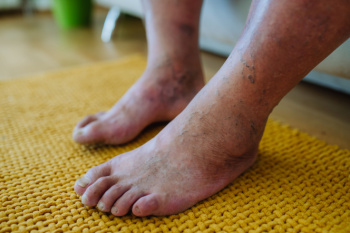
Diabetes requires ongoing medical care beyond controlling blood sugar. Foot ulcers, a common complication, pose serious health risks. 19% to 34% of people with diabetes are likely to develop a foot ulcer at least once in their lifetime. There is a 2% yearly incidence of diabetic patients developing foot ulcers, with high recurrence rates after healing. Poor foot care raises the risk of a diabetic patient developing ulcers, infections, and amputations. Studies show varied foot care practices globally can contribute to injury risk. These include infrequent foot and shoe checks, inadequate foot hygiene, and walking barefoot. To reduce diabetic foot complications, patients need education on proper foot care, regular check-ups, and to avoid risky behaviors, like walking barefoot or wearing improper footwear. If you are a diabetic, it is strongly suggested that you make regular visits with a podiatrist for routine examinations and care.
Diabetic foot care is important in preventing foot ailments such as ulcers. If you are suffering from diabetes or have any other concerns about your feet, contact Monique Mitchell, DPM from Family Foot Centre. Our doctor can provide the care you need to keep you pain-free and on your feet.
Diabetic Foot Care
Diabetes affects millions of people every year. The condition can damage blood vessels in many parts of the body, especially the feet. Because of this, taking care of your feet is essential if you have diabetes, and having a podiatrist help monitor your foot health is highly recommended.
The Importance of Caring for Your Feet
- Routinely inspect your feet for bruises or sores.
- Wear socks that fit your feet comfortably.
- Wear comfortable shoes that provide adequate support.
Patients with diabetes should have their doctor monitor their blood levels, as blood sugar levels play such a huge role in diabetic care. Monitoring these levels on a regular basis is highly advised.
It is always best to inform your healthcare professional of any concerns you may have regarding your feet, especially for diabetic patients. Early treatment and routine foot examinations are keys to maintaining proper health, especially because severe complications can arise if proper treatment is not applied.
If you have any questions please feel free to contact our office located in Garden Hills, Nassau, Bahamas . We offer the newest diagnostic and treatment technologies for all your foot and ankle needs.
Diabetic Foot Care
Diabetes affects millions of people every year. Blood vessels located all over the body are damaged due to diabetes—even the blood vessels of the feet. Neuropathy, or nerve damage, can result from slower blood flow in the legs and feet. In diabetic patients, neuropathy is very important to monitor, as diabetics are at risk for developing ulcers.
Always washing and thoroughly drying the feet are pertinent parts of diabetic foot care. There should be a focus on cleaning between the toes. Even if no pain is felt, the entire foot should be examined for redness and sores. Neuropathy can often mask the pain of sores and ulcers and can cause these conditions to be overlooked. Use a mirror to examine the underside of your feet if needed. It is recommended that diabetics wear well-fitting socks.
Patients with diabetes should have their doctor monitor their blood levels because blood sugar levels play a huge role in diabetic care. Monitoring these levels on a regular basis is highly advised. It is very important to keep your blood sugar levels in the normal range, which can be determined by your physician. There are medications that may be prescribed to help with any neuropathy experienced by the diabetic patient. It is also advisable to visit a podiatrist if one is experiencing any conditions involving the feet, such as ingrown toenails, which in more severe cases can cause infection.
Diabetic feet must be inspected daily. Diabetic foot care at home is possible if a patient is provided with instructions from their podiatrist. Patients can relieve dry heels with creams or ointments. Suspected wounds should warrant an immediate call to the podiatrist. Gangrene is a serious problem for diabetics and can lead to sepsis and amputation in its worst cases. Early treatment and daily inspection of diabetic feet are keys to staying healthy.
Consulting a Podiatrist for Help With Athlete’s Foot

A podiatrist can diagnose and treat athlete's foot. Podiatrists are specialized healthcare professionals trained to address various foot and ankle conditions, including fungal infections such as athlete's foot. Upon examination, a podiatrist can accurately diagnose the infection and assess its severity. They may perform tests such as skin scrapings or cultures to confirm the presence of the fungus. Once diagnosed, a podiatrist can recommend appropriate treatment options tailored to the individual's needs. This may include prescribing antifungal medications, both topical and oral, to eradicate the fungus effectively. Additionally, they can provide guidance on proper foot hygiene practices to prevent recurrence and reduce the risk of spreading the infection to others. If you think you may have athlete’s foot, it is suggested that you schedule an appointment with a podiatrist for comprehensive care and long-term management of the condition.
Athlete’s Foot
Athlete’s foot is often an uncomfortable condition to experience. Thankfully, podiatrists specialize in treating athlete’s foot and offer the best treatment options. If you have any questions about athlete’s foot, consult with Monique Mitchell, DPM from Family Foot Centre. Our doctor will assess your condition and provide you with quality treatment.
What Is Athlete’s Foot?
Tinea pedis, more commonly known as athlete’s foot, is a non-serious and common fungal infection of the foot. Athlete’s foot is contagious and can be contracted by touching someone who has it or infected surfaces. The most common places contaminated by it are public showers, locker rooms, and swimming pools. Once contracted, it grows on feet that are left inside moist, dark, and warm shoes and socks.
Prevention
The most effective ways to prevent athlete’s foot include:
- Thoroughly washing and drying feet
- Avoid going barefoot in locker rooms and public showers
- Using shower shoes in public showers
- Wearing socks that allow the feet to breathe
- Changing socks and shoes frequently if you sweat a lot
Symptoms
Athlete’s foot initially occurs as a rash between the toes. However, if left undiagnosed, it can spread to the sides and bottom of the feet, toenails, and if touched by hand, the hands themselves. Symptoms include:
- Redness
- Burning
- Itching
- Scaly and peeling skin
Diagnosis and Treatment
Diagnosis is quick and easy. Skin samples will be taken and either viewed under a microscope or sent to a lab for testing. Sometimes, a podiatrist can diagnose it based on simply looking at it. Once confirmed, treatment options include oral and topical antifungal medications.
If you have any questions, please feel free to contact our office located in Garden Hills, Nassau, Bahamas . We offer the newest diagnostic and treatment technologies for all your foot care needs.
